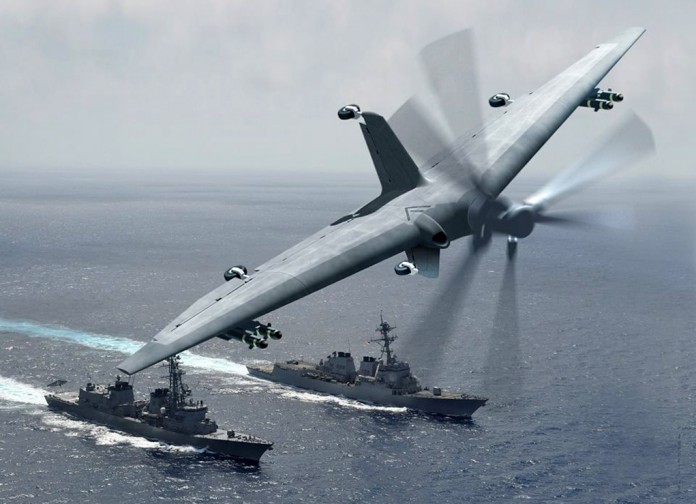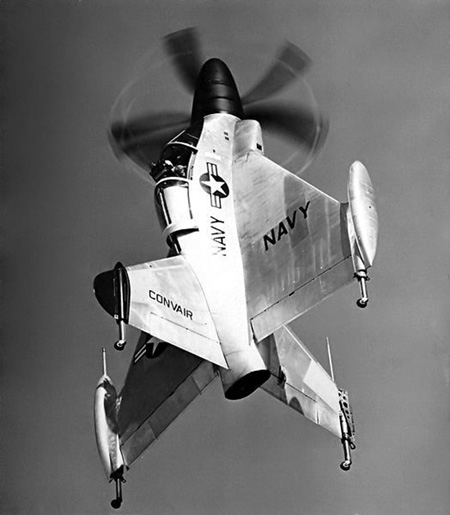
DARPA awarded Northrop Grumman US$93 million for under the 3rd phase of the Tern program. The company will develop and demonstrate an innovative tail-sitting, flying-wing aircraft with twin counter-rotating, nose-mounted propellers that will be able to deploy from the flight decks of frigates. The propellers would lift the aircraft from a ship deck, orient it for horizontal flight and provide propulsion to complete a mission. They would then reorient the craft upon its return and lower it to the ship deck. The system would fit securely inside the ship when not in use.

Tern is a joint program between DARPA and the U.S. Navy’s Office of Naval Research (ONR), that seeks to develop an unmanned aerial system that deploys from frigates and destroyer size vessels, to perform medium altitude, long endurance (MALE) missions. DARPA has awarded Phase 3 of Tern to a team led by the Northrop Grumman Corporation.
Under this contract Northrop Grumman will build a full-scale demonstrator drone of this type to be used in ground-based testing. If successful, the program will proceed to demonstrate the drone’s capability to deploy at sea, performing takeoff, transition to and from horizontal flight, and landing—all from a test platform with a deck size similar to that of a destroyer or other small surface-combat vessel.
Ideally, Tern would enable on-demand, ship-based unmanned aircraft systems (UAS) operations without extensive, time-consuming and irreversible ship modifications. It would provide small ships with a “mission truck” that could transport ISR and strike payloads to very long distances from the host vessel. The solution would support field-interchangeable mission packages for both overland and maritime missions. It would operate from multiple ship types and in elevated sea states.
[nonmember]
This is an abstract of 860 word article available for Defense-Update members.
[/nonmember][ismember]The vehicle is a high-aspect-ratio flying wing with a span of about 30 ft., with modest leading-edge sweep and four main control surfaces on the trailing edge. Four wheels, two mounted on the trailing edge and two on sponsons projecting above and below the wing, act as landing gear. The wheels do not retract in forward flight.
Thrust for vertical lift and forward flight is provided by 10-ft.-dia. contra-rotating rotors mounted centrally on the leading edge. A single inlet for the powerplant is located to one side of the rotor hub, close to the leading edge. According to Aviation Week, Northrop Grumman is planning to begin wind tunnel testing of its new design in January 2016. flight Small-deck ships such as destroyers and frigates could greatly increase their effectiveness if they had their own unmanned air systems (UASs) to provide intelligence, surveillance and reconnaissance (ISR) and other capabilities at long range around the clock. Current state-of-the-art UASs, however, lack the ability to take off and land from confined spaces in rough seas and achieve efficient long-duration flight.
The ‘Tactically Exploited Reconnaissance Node (TERN) program’ will introduce groundbreaking capabilities that have been on the Navy’s wish list in one form or another since World War II. The production of the first practical helicopters in 1942 helped the U.S. military realize the potential value of embedded vertical takeoff and landing (VTOL) aircraft to protect fleets and reduce the reliance on aircraft carriers and land bases.
The Tern demonstrator will bear some resemblance to the Convair XFY-1 Pogo, an experimental ship-based VTOL fighter designed by the Navy in the 1950s to provide air support for fleets. Despite numerous successful demonstrations, the XFY-1 never advanced beyond the prototype stage, in part because the Navy at the time was focusing on faster jet aircraft and determined that pilots would have needed too much training to land on moving ships in rough seas.
“Moving to an unmanned platform, refocusing the mission and incorporating modern precision relative navigation and other technologies removes many of the challenges the XFY-1 and other prior efforts faced in developing aircraft based from small ships,” Dan Patt, DARPA program manager said. “Tern is a great example of how new technologies and innovative thinking can bring long-sought capabilities within reach.”
“The design we have in mind for the Tern demonstrator could greatly increase the effectiveness of any host ship by augmenting awareness, reach and connectivity,” Pat said. “We continue to make progress toward our goal to develop breakthrough technologies that would enable persistent ISR and strike capabilities almost anywhere in the world at a fraction of current deployment costs, time and effort.”
“Through Tern, we seek to develop and demonstrate key capabilities for enabling distributed, disaggregated U.S. naval architectures in the future,” said Bradford Tousley, director of DARPA’s Tactical Technology Office (TTO), which oversees Tern. “This joint DARPA-Navy effort is yet another example of how the Agency collaborates with intended transition partners to create potentially revolutionary capabilities for national security.”
DARPA and the Navy have a Memorandum of Agreement (MOA) to share responsibility for the development and testing of the Tern demonstrator system. The Marine Corps Warfighting Laboratory (MCWL) has also expressed interest in Tern’s potential capabilities and is providing support to the program.[/ismember]



















